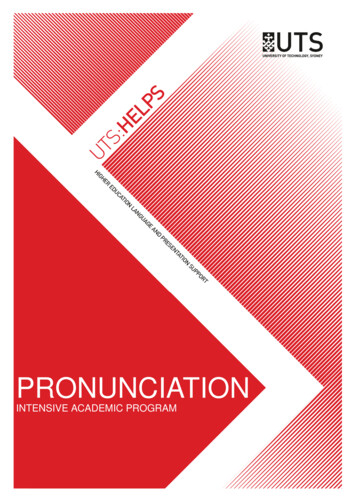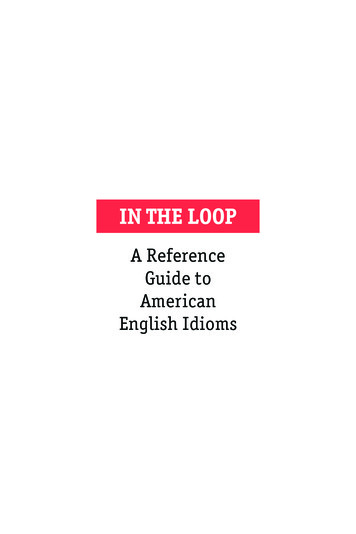
Transcription
THE AMERICAN ACCENT GUIDEFOR SPANISH SPEAKERSBy Hadar ShemeshClick to watch videoIn this guide, you will learn about the most common pronunciation challenges Spanishspeakers face, how to overcome them, and how to PRACTICE effectively in order toimprove your accent and clarity in English. Daily practice and repetition of sounds willhelp you create awareness, and help you develop the muscle memory needed topronounce the sounds and words correctly with little effort!
Here are the 10 most common mistakes made by Spanish speakers:(Don’t forget to listen to the audio and to practice along)MISTAKE #1:Dropping final consonants at the end of wordsIn Spanish, words never end in a consonant cluster (when two or more consonants arepronounced together with no vowels between them, for example, strength, loved, texts).While clusters may appear at the beginning or middle of words in Spanish (español,hombre, crédito) they never appear at the end of words and are almost impossible forSpanish speakers to pronounce.Therefore, it is very likely for Spanish speakers to unintentionally drop one or twoconsonant sounds if they are part of a final consonant sequence in order to bring thepronunciation closer to what’s possible in Spanish - a single consonant. Practice the following words, make sure you pronounce all thTextsWorkedBuildwww.TheAccentsWay.com Hadar Shemesh 20202
MISTAKE #2:Substituting a final M with NThe M consonant sound exists in Spanish, but it never appears at the end of words.Therefore, while it’s not at all difficult for Spanish speakers to pronounce the M alone, itcan be quite challenging for them to pronounce it at the end of words.This is why when a word ends with M in English (some, ham, cream)Spanish speakers may substitute it with the closest sound available that does show up atthe end of words in Spanish - N (or NG).This substitution usually happens subconsciously, and awareness is the number onefactor in improving this pronunciation challenge.The word ‘game’ is pronounced as ‘gain’The word ‘seem’ is pronounced as ‘seen’The word ‘foam’ is pronounced as ‘phone’ Practice: First, pronounce the M clearly at the end of each of the followingwords, make sure your lips are closed and that you are not pronouncing an/n/ instead of the ay.com Hadar Shemesh 20203
Now, pronounce the following pairs, making sure they don’t sound the same:Home- honeSum-sonFoam - -turnskim-skinMISTAKE #3:Z is pronounced as SSince there’s no Z (as in zoo) in Spanish, the Z sound is often misplaced with an S,especially when it appears in the middle or end of words.The Z is the voiced pair of the S consonant sound. Basically, they are pronounced thesame, except that for the fact that with the Z sound, the vocal cords are vibrating.It’s very easy to make this mistake since both sounds look and feel the same, except forthe vibrations of the vocal cords.This is also a result of the orthography (the way words are written and the spelling). SinceEnglish, unlike Spanish, is not a phonetic language, many times the /z/ sound isrepresented by the letter ‘s’. In Spanish, the letter ‘s’ always represents a /s/ sound. Thatcreates an additional challenge and confusion related to the perception of how the wordshould sound (unfortunately, most speakers learn English by reading and writing first andtheir listening skills are compromised).www.TheAccentsWay.com Hadar Shemesh 20204
Practice: The words below have an ‘s’, but should be pronounced like /z/.Practice sonMISTAKE #4:The /y/ (As in ‘yes’) consonant soundand the /j/ (as in ‘job) switch placesOftentimes, Spanish speakers may pronounce the /y/ consonant sound as in ‘yes’ ‘years’and ‘yellow’ as a /j/ sound, pronouncing it as jes, jears, and jello (by the way, this is notthe same /j/ as in ‘jalapeno’).Also, quite often the substitution will be reversed too.A word that begins with ‘j’ will be pronounced with a /y/Yob instead of jobYust instead of just.www.TheAccentsWay.com Hadar Shemesh 20205
Practice the two sounds separately YardJam And then in minimal pairs (do you pronounce them the same?)Yet-jetYam-jamYolk-jokeYell-jellYacht - jotwww.TheAccentsWay.com Hadar Shemesh 20206
MISTAKE #5:Different vowels are pronounced the sameIn Spanish, there are 5 vowels (a, e, i, o, u) while in English there are about 16; none ofthem really correspond with the English sounds.Since most Spanish speakers are not familiar or comfortable with the pronunciation ofvowels in English, they tend to merge similar vowels into the closest vowel sound inSpanish.Example of different words that are usually pronounced the same:sheep-ship, reach-rich, leave- live (watch a video tutorial about the sheep-ship vowel pair)pool-pull, food-foot, fool-full (watch a video tutorial about the pool-pull vowel pair). Distinguish between similar vowel tWho’d chBoot-bookClick here for a video tutorial about the 'sheep-ship'Click here for a video tutorial about the 'pool-pull'www.TheAccentsWay.com Hadar Shemesh 2020
MISTAKE #6:The /v/ consonant is pronounced as /b/Since the pronunciation of the letter ‘v’ in Spanish is more similar to the pronunciation of/b/ in English, this pronunciation carries over to English as well.The V is a fricative and to pronounce it, the bottom lip has to touch the top teeth, and airpasses between the teeth and the lips (it’s a voiced sound).The B is created as both lips close and touch each other.If a B is pronounced in place of a ‘v’, words may change meaning:‘very’ will sound like ‘bury’ and ‘vote’ will sound like ‘boat’. Practice: Make sure these two words do not sound the same!Very - berryFiver - fiberVote - boatCurve- curbVet - betVat - batVow - bowVest - bestwww.TheAccentsWay.com Hadar Shemesh 20208
MISTAKE #7:The American R is replaced with a Spanish /r/The Spanish R and American R are pronounced differently.In Spanish, there are two R’s (pero, perro) and for both sounds, the tip of the tonguetouches the upper palate.For the R in English, the tip of the tongue doesn’t touch the upper palate, but curls back abit as the lips round (click to watch a video tutorial about the R).Spanish speakers often pronounce the American R as they would pronounce the SpanishR, bringing the tip of the tongue to touch the upper palate. Practice: Make sure the tip of your tongue doesn’t touch the upper palatewhen pronouncing the atch video tutorial: The American Rwww.TheAccentsWay.com Hadar Shemesh 20209
MISTAKE #8:Mispronouncing the HSince the letter H is silent in Spanish, and in American English it is generally pronounced(not always, you can learn more about the H here), some speakers mispronounce the Hand create a velar fricative instead (just like the ‘j’ sound in ‘jalapeno’).While the H in English is soft and sounds like a whisper, the substitution is moredominant - the back of the tongue is high and close to the soft palate. Practice: Pronounce the H clearly in the following words, and keep yourthroat oWatch a video tutorial about the Hwww.TheAccentsWay.com Hadar Shemesh 202010
.MISTAKE #9:A vowel is added to words beginning with /st/In Spanish, a word will never begin in a consonant cluster. To simplify the ‘impossible’pronunciation of words that begin with ‘st’ in English, Spanish speakers add the /e/ vowelsound to words that begin with ‘st’.‘estreet’ instead of ‘street’, ‘estrange’ instead of ‘strange’. Practice the words and make sure you don’t add a vowel ickStrengthStayMISTAKE #10:The /th/ consonant sound is substituted with /t/ or /d/For the TH, the tongue has to stick out from between the teeth.Since Spanish speakers don’t have the TH consonant sound in their language,they tend to keep the tongue inside for words with TH.It is a common mispronunciation and sometimes will result in pronouncing differentwords the same.The /th/ in ‘thanks’ (soft, voiceless TH) will be replaced with a /t/ and the word will soundwww.TheAccentsWay.com Hadar Shemesh 202011
like ‘tanks’. The /th/ in ‘they’ (voiced) will be replaced with a /d/ and the word will soundlike ‘day’.Interestingly enough, the voiced TH does occur in Spanish, unintentionally, when the dappears between two vowels, (for example in ‘pedir’, ‘estado’, ‘lodo’). It’s called anallophone.Simplifying the TH: video lesson Practice: Stick the tongue out and release air when pronouncing thefollowing ngFatherBathbreathingAnd remember.Practice Makes Better!( cause perfection is overrated)www.TheAccentsWay.com Hadar Shemesh 202012
THE AMERICAN ACCENT GUIDE FOR SPANISH SPEAKERS By Hadar Shemesh Click to watch video In this guide, you will learn about the most common pronunciation challenges Spanish speakers face, how to o










